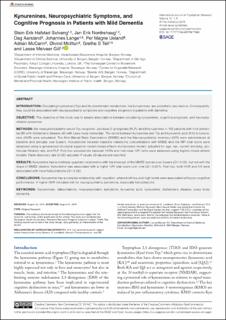| dc.contributor.author | Solvang, Stein-Erik Hafstad | |
| dc.contributor.author | Nordrehaug, Jan Erik | |
| dc.contributor.author | Aarsland, Dag | |
| dc.contributor.author | Lange, Johannes | |
| dc.contributor.author | Ueland, Per Magne | |
| dc.contributor.author | McCann, Adrian | |
| dc.contributor.author | Midttun, Øivind | |
| dc.contributor.author | Tell, Grethe S. | |
| dc.contributor.author | Melvær, Giil Lasse | |
| dc.date.accessioned | 2021-02-08T14:36:04Z | |
| dc.date.available | 2021-02-08T14:36:04Z | |
| dc.date.created | 2020-03-10T14:43:45Z | |
| dc.date.issued | 2019 | |
| dc.Published | International Journal of Tryptophan Research. 2019, 12, 1-9. | en_US |
| dc.identifier.issn | 1178-6469 | |
| dc.identifier.uri | https://hdl.handle.net/11250/2726666 | |
| dc.description.abstract | Introduction: Circulating tryptophan (Trp) and its downstream metabolites, the kynurenines, are potentially neuroactive. Consequently, they could be associated with neuropsychiatric symptoms and cognitive prognosis in patients with dementia.
Objective: The objective of this study was to assess associations between circulating kynurenines, cognitive prognosis, and neuropsychiatric symptoms.
Methods: We measured baseline serum Trp, neopterin, pyridoxal 5'-phosphate (PLP), and 9 kynurenines in 155 patients with mild dementia (90 with Alzheimer's disease, 65 with Lewy body dementia). The ratios between kynurenine and Trp and kynurenic acid (KA) to kynurenine (KKR) were calculated. The Mini-Mental State Examination (MMSE) and the Neuropsychiatric Inventory (NPI) were administered at baseline and annually over 5 years. Associations between baseline metabolite concentrations with MMSE and the NPI total score were assessed using a generalized structural equation model (mixed-effects multiprocess model), adjusted for age, sex, current smoking, glomerular filtration rate, and PLP. Post hoc associations between KKRs and individual NPI items were assessed using logistic mixed-effects models. False discovery rate (0.05)-adjusted P values (Q values) are reported.
Results: Kynurenine had a nonlinear quadratic relationship with the intercept of the MMSE scores over 5 years (Q < 0.05), but not with the slope of MMSE decline. Kynurenine was associated with a higher NPI total score over time (Q < 0.001). Post hoc, both KKR and KA were associated with more hallucinations (Q < 0.05).
Conclusions: Kynurenine has a complex relationship with cognition, where both low and high levels were associated with poor cognitive performance. A higher KKR indicated risk for neuropsychiatric symptoms, especially hallucinations. | en_US |
| dc.language.iso | eng | en_US |
| dc.publisher | SAGE Publications | en_US |
| dc.rights | Navngivelse-Ikkekommersiell 4.0 Internasjonal | * |
| dc.rights.uri | http://creativecommons.org/licenses/by-nc/4.0/deed.no | * |
| dc.title | Kynurenines, Neuropsychiatric Symptoms, and Cognitive Prognosis in Patients with Mild Dementia | en_US |
| dc.type | Journal article | en_US |
| dc.type | Peer reviewed | en_US |
| dc.description.version | publishedVersion | en_US |
| dc.rights.holder | Copyright The Author(s) 2019. | en_US |
| cristin.ispublished | true | |
| cristin.fulltext | original | |
| cristin.qualitycode | 1 | |
| dc.identifier.doi | 10.1177/1178646919877883 | |
| dc.identifier.cristin | 1800936 | |
| dc.source.journal | International Journal of Tryptophan Research (IJTR) | en_US |
| dc.source.40 | 12 | en_US |
| dc.source.pagenumber | 1-9 | en_US |
| dc.identifier.citation | International Journal of Tryptophan Research. 2019, 12. | |

